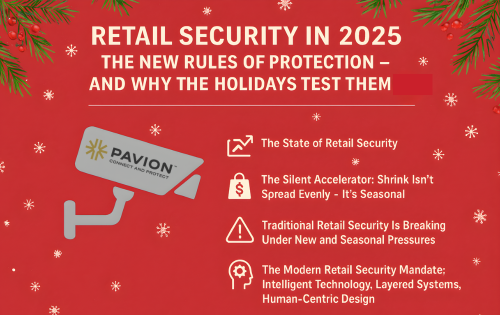
Improving Business Operations with Advanced Access Control
Access control is a critical aspect of modern business operations. It allows organizations to secure their facilities, protect sensitive information, and effectively manage access rights for their employees and visitors. With the advancement of technology, traditional access control systems have evolved into more sophisticated and efficient solutions that offer a wide range of benefits.At Pavion, we specialize in providing advanced access control solutions that help businesses streamline their operations, enhance security, and ensure compliance. In this article, we will explore the basics of access control, discuss the key features of advanced access control systems, and explore the role of advanced access control in business improvement. We will also provide insights into implementing advanced access control in your business and offer some best practices for implementation and management.
Understanding the Basics of Access Control
Access control refers to the mechanisms and processes that govern who is allowed to enter or access a facility, system, or resource. It encompasses various technologies, such as access cards, keypads, biometric readers, and software applications that manage access rights. Access control systems play a crucial role in ensuring the security and safety of a business by preventing unauthorized access and controlling the flow of people within the premises.
Access control is a fundamental aspect of security management. It involves the implementation of policies and procedures to regulate access to physical and digital assets. By effectively managing access control, organizations can protect their valuable resources, maintain confidentiality, and safeguard against potential threats.
Defining Access Control in Business Operations
In the context of business operations, access control is about managing physical access to facilities, as well as digital access to systems and data. It involves identifying individuals, authenticating their credentials, and authorizing them to access specific areas or resources based on their roles and responsibilities.
Physical access control measures include traditional methods such as locks and keys, as well as more advanced technologies like access cards and biometric readers. These systems ensure that only authorized personnel can enter restricted areas, reducing the risk of theft, vandalism, or unauthorized activities.
Digital access control, on the other hand, focuses on managing access to computer systems, networks, and data. It involves implementing authentication mechanisms, such as passwords, two-factor authentication, or biometric recognition, to verify the identity of users. By granting access privileges based on user roles and responsibilities, organizations can ensure that only authorized individuals can access sensitive information and perform specific actions.
The Importance of Advanced Access Control
Advanced access control systems offer several advantages over traditional systems. They provide businesses with enhanced security features, more flexibility in managing access rights, and better visibility into access activities.
One of the key benefits of advanced access control is the ability to integrate multiple technologies into a comprehensive system. For example, organizations can combine access cards with biometric readers to create a multi-factor authentication process, adding an extra layer of security. Additionally, advanced access control systems often come with advanced reporting and auditing capabilities, allowing businesses to track and monitor access activities in real-time.
Another advantage of advanced access control is the flexibility it offers in managing access rights. With traditional systems, granting or revoking access privileges can be a time-consuming process. However, advanced systems allow for centralized management, making it easier to add or remove users, update access levels, and modify permissions. This flexibility not only improves operational efficiency but also reduces the risk of human error in access control management.
Furthermore, advanced access control systems provide better visibility into access activities. They generate detailed logs and reports, allowing organizations to identify patterns, detect anomalies, and investigate any suspicious behavior. This visibility helps businesses proactively address security issues and prevent potential breaches.
By investing in advanced access control solutions, businesses can significantly improve their overall security posture and protect sensitive information from potential threats. These systems not only enhance physical and digital security but also provide organizations with peace of mind, knowing that their assets are well-protected.
Key Features of Advanced Access Control Systems
Advanced access control systems offer a range of features that enable businesses to have better control over their access management processes. Let’s explore some of the key features:
User Identification and Authentication
An advanced access control system allows businesses to accurately identify and authenticate individuals before granting them access. This can be done through various methods, such as biometric verification, smart cards, or unique identifiers. By ensuring that only authorized personnel can enter restricted areas, businesses can minimize the risk of unauthorized access and potential security breaches.
Biometric verification is one of the most secure methods of user identification and authentication. It uses unique physical or behavioral characteristics, such as fingerprints, iris patterns, or voice recognition, to verify an individual’s identity. This technology provides a high level of accuracy and eliminates the risk of unauthorized access due to stolen or lost access cards.
Smart cards, on the other hand, are portable devices that store and process data. They can be used to store personal information, access credentials, and even biometric data. When a user presents a smart card to an access control system, the system reads the data stored on the card and verifies the user’s identity before granting access.
Unique identifiers, such as personal identification numbers (PINs) or passwords, are commonly used in combination with other authentication methods. These identifiers provide an additional layer of security by requiring users to enter a secret code that only they know.
Authorization and Access Levels
With advanced access control, businesses can define granular access levels and permissions for different individuals or groups. This allows for more precise control over who can access specific areas or resources within the organization. By implementing role-based access control (RBAC) or attribute-based access control (ABAC), businesses can ensure that employees have access to the resources they need to perform their tasks effectively while preventing access to sensitive or restricted areas.
RBAC is a widely used access control model that assigns permissions based on job roles. Each role is associated with a set of permissions that determine what actions a user with that role can perform. For example, an employee with a “manager” role may have access to sensitive financial data, while an employee with a “sales representative” role may only have access to customer information.
ABAC, on the other hand, takes a more dynamic approach to access control by considering various attributes of the user, the resource being accessed, and the context of the access request. This allows for more fine-grained control over access permissions. For example, a user may be granted access to a specific file only if they are accessing it from a trusted device and during specific hours of the day.
Audit Trails and Reporting
Advanced access control systems provide robust audit trail capabilities, allowing businesses to track and monitor access activities in real-time. These systems capture detailed information about each access event, including the date, time, location, and the identity of the individual. This information can be invaluable for investigations, compliance audits, or identifying patterns of unauthorized access.
By analyzing the audit trail data, businesses can gain insights into access patterns and identify potential security risks. For example, if multiple failed access attempts are recorded for a specific user, it may indicate a potential security breach or an attempt to gain unauthorized access. Similarly, if an employee’s access patterns suddenly change, such as accessing sensitive data outside of their usual working hours, it may raise a red flag and prompt further investigation.
Comprehensive reporting features further enhance the visibility and control businesses have over their access management processes. These reports can provide valuable information on access trends, compliance status, and potential areas for improvement. By regularly reviewing these reports, businesses can ensure that their access control systems are effective and aligned with their security policies.
The Role of Advanced Access Control in Business Improvement
Implementing advanced access control systems can have a transformative impact on business operations. Let’s explore some ways in which advanced access control can contribute to business improvement:
Enhancing Security and Reducing Risk
By implementing advanced access control systems, businesses can significantly enhance their security measures, reducing the risk of unauthorized access and potential breaches. Restricting access to sensitive areas or resources prevents unauthorized individuals from tampering with critical systems, stealing confidential information, or causing physical harm. These systems act as a powerful deterrent, ensuring that only authorized personnel can access secure areas.
Streamlining Operational Efficiency
Advanced access control systems streamline the process of granting and revoking access rights, reducing administrative burden and saving valuable time. With centralized access control management, businesses can efficiently manage access permissions across multiple locations, departments, or facilities. Moreover, features like automatic scheduling or integration with other business systems, such as human resources, can further optimize access management processes and improve overall operational efficiency.
Ensuring Compliance and Governance
In many industries, compliance and adherence to regulations are critical. Advanced access control systems help businesses meet compliance requirements by ensuring that access to sensitive areas or resources is properly managed and audited. By maintaining detailed records of access events and implementing strong access control measures, businesses can demonstrate compliance with industry-specific regulations or standards, reducing the risk of penalties or legal repercussions.
Implementing Advanced Access Control in Your Business
When considering the implementation of advanced access control systems, there are several factors to consider:
Evaluating Your Current Access Control System
Before making any changes, it is essential to assess your current access control system’s strengths and weaknesses. Identify pain points, security gaps, or operational inefficiencies that can be addressed by implementing advanced access control. Understanding your specific requirements will help you choose the most suitable solution for your business.
Choosing the Right Advanced Access Control System
There are various advanced access control solutions available in the market. It is crucial to select a system that aligns with your business needs, budget, and scalability requirements. Look for features such as robust user authentication, flexible access control policies, and comprehensive reporting capabilities. Additionally, consider factors such as ease of use, integration capabilities, and ongoing support when choosing a system.
Best Practices for Implementation and Management
Successful implementation and management of an advanced access control system require careful planning and execution. Some best practices include conducting a pilot program before full-scale deployment, involving key stakeholders in the decision-making process, and providing thorough training to employees on the proper use of the system. Ongoing monitoring, maintenance, and regular system updates are also essential to ensure optimal performance and security.
As a leader in advanced access control solutions, Pavion can assist your business in implementing and managing a robust access control system tailored to your specific needs. Our expertise and proven track record have helped numerous organizations enhance security, streamline operations, and achieve regulatory compliance. Contact us today to discuss how we can support your business in improving its operations through advanced access control.
Take the Next Step with Pavion
Ready to elevate your business’s security and operational efficiency? Pavion is here to guide you through the transformation. With our tailored fire, security, and integration solutions, we empower organizations across various industries to connect and protect what matters most. Don’t miss the opportunity for a Free System Assessment that will pave the way for enhanced safety, security, and communication within your enterprise. Get a Free System Assessment today and experience the Pavion difference in service and innovation.


